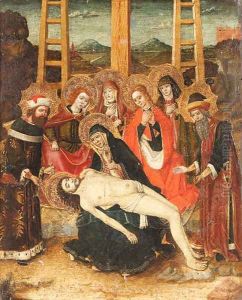Sicilian School Paintings
The Sicilian School was not a single artist but a group of poets and writers who flourished in Sicily during the 13th century, specifically from around 1230 to 1290. This movement marked a significant period in the history of Italian literature, being instrumental in the development of early Italian poetry. The Sicilian School is noteworthy for its pioneering use of the vernacular, specifically in the Sicilian dialect, which laid the groundwork for the Italian literary language. It emerged under the patronage of the Holy Roman Emperor Frederick II and his court in Palermo, a cultural melting pot of the time, which included not just Italians but also Provençals, Germans, Muslims, and Jews, making the court a diverse and vibrant center for intellectual and cultural exchange.
The Sicilian poets, often referred to as the 'Sicilian poets' circle', were primarily concerned with themes of courtly love, a concept they inherited from the troubadours of Provence but adapted to their unique cultural context. Their poetry, characterized by its formal elegance and the refinement of its lyrical subject matter, was a significant departure from the earlier, more robust and oral traditions of Italian verse. The most famous exponent of the Sicilian School was Giacomo da Lentini, credited with inventing the sonnet form, which would later be perfected by Petrarch and become a staple of Italian poetry.
The influence of the Sicilian School extended beyond the confines of Sicily and the reign of Frederick II, influencing the development of Italian literature as a whole. Its emphasis on the vernacular as a vehicle for poetry contributed to the elevation of Italian to a literary language, paving the way for the later works of Dante Alighieri, Petrarch, and Boccaccio. The legacy of the Sicilian School lies in its foundational role in the establishment of a tradition of Italian vernacular literature, a tradition that would reach its zenith in the works of these later poets. Despite the original works of the Sicilian poets being relatively few and often preserved only in fragments, their impact on the trajectory of Italian literary history is indisputable.
